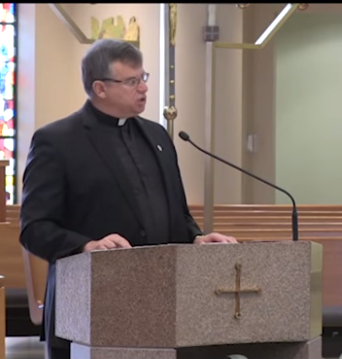 Considering Consecrated Life “What’s the Rush?”
Considering Consecrated Life “What’s the Rush?”
“I’ve learned to stop rushing things that need time to grow.”
Rushing. That word certainly has a negative flavor, especially when applied to something worthwhile. Yet it does capture for me what sometimes happens during the Triduum.
The Triduum, as we all know, involves us in three great moments of our faith: Holy Thursday, Good Friday, and the Easter Vigil. Each of these celebrations contains a particular part which takes a long time: the washing of the feet on Holy Thursday, the reverencing of the cross on Good Friday, and the readings of the Easter Vigil. For legitimate pastoral reasons, each of these sections often receives a downsizing which takes different forms for each liturgy. In a perfect world, what would be the value of allowing each of these pieces its full vigor? I suggest that the answer to that question is meditation/reflection.
On Holy Thursday, the summons to wash the feet of members of the community intends to recognize the way in which Jesus washed the feet of his twelve disciples. One must visualize Jesus going to each of his disciples balancing a basin, a ewer of water, and a towel. He kneels at the apostle’s feet. He washes and dries each foot attentively. To do that for all of his followers must have taken some time. We can imagine the others watching silently or speaking excitedly as he moved from person to person. When the Lord finished, he explains that he had offered an example of service, and they should take that lesson to heart.
The meditation presented for the Christian community lies in the issue of service. How long that reflection can proceed depends on the time required for the action of washing. Perhaps it also depends on the preparation of the community and the placement of those who are to have their feet washed. The story of the washing of the feet in John’s Gospel finds its place at the “Last Supper.” The Fourth Gospel sets this narrative in that same situation in which the institution of the Eucharist occurs in the Synoptics and in Paul. What is the connection? It is a worthy meditation each year.
On Good Friday, the reverencing of the cross takes place. I love this part of the service. Watching everyone in a Church making their way to the same cross and offering some sign of devotion is extraordinary. In my mind’s eye, I visualize the scene on Calvary. Once Jesus had died, I presume that the soldiers on guard lost interest in him. Their job was over. At that moment, I imagine those who had the courage to remain faithful rushed to the foot of the cross and touched or kissed or held his body. Perhaps they also reverenced the wood on which his life had been handed over. Perhaps, even after the removal of his body for burial, some remained at the cross unable to fully grasp what had happened there, in that place, on that wood.
The well-known devotion of both Vincent and Louis to the cross rests at the heart of their spirituality. (Bob Maloney has written on this topic: “The Cross in Vincentian Spirituality,” Vincentian Heritage Journal. Vol. 16:1. 1995.) Our founders offer much food for reflection. On Good Friday, the length of the line of those going to reverence the cross defines the time during which people can reflect on its meaning for themselves and for all of those who make the procession. One cannot exaggerate the centrality of the cross in Christian theology. St. Paul stands at the head of this insistence:
“The message of the cross is foolishness to those who are perishing, but to us who are being saved it is the power of God.” (1 Cor 1:18)
An extended reflection on the meaning of the cross is rewarding at any time, but most especially on Good Friday.
The nine readings (seven from the Old Testament joined to the Epistle and Gospel) mete out a genuine exercise in listening to the Word of God at the Easter Vigil. No effort has been made to keep the readings short or simple. Added to these texts are the responsorial psalms and prayers. The intent to move the community through the events of our salvation sometimes feels like a literal re-living of the history. Without question, the presentation of all the texts at the Vigil invites an authentic labor for the gathered community.
Of all the lengthy elements of the Triduum, these readings on the most holy of nights bring the most challenge. The washing of the feet and the reverencing of the cross place one at the center of repetitive action which, in turn, enables a more focused, silent, contemplation. The accounts proclaimed at the Vigil require an attentive and dynamic hearing. Little time arises to stop and consider the implications of the text. One is swept along by the action as centuries are invoked and left behind. No liturgy demands as much preparation or reflection beforehand. Fatigue and analysis receive slight allowance. To be alive at the Vigil is to be truly engaged in the effort of heeding.
Yes, a rush can categorize our celebration of the three great days of our faith. I understand the reasons, but I also feel the consequences. The season of Lent receives numerous emphases as the time of gestation for the central mystery of our faith. The preparation readies us for the gentle and gradual revelation of its expression. In this “Year of Consecrated Life,” though I may not have the ability to change the planning of the celebrations, I can attend to the call for patient prayer and reflection when the rhythm offers that opportunity.





0 Comments